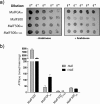Formation of a Chloride-conducting State in the Maltose ATP-binding Cassette (ABC) Transporter
- PMID: 27059961
- PMCID: PMC4933262
- DOI: 10.1074/jbc.M115.711622
Formation of a Chloride-conducting State in the Maltose ATP-binding Cassette (ABC) Transporter
Abstract
ATP-binding cassette transporters use an alternating access mechanism to move substrates across cellular membranes. This mode of transport ensures the selective passage of molecules while preserving membrane impermeability. The crystal structures of MalFGK2, inward- and outward-facing, show that the transporter is sealed against ions and small molecules. It has yet to be determined whether membrane impermeability is maintained when MalFGK2 cycles between these two conformations. Through the use of a mutant that resides in intermediate conformations close to the transition state, we demonstrate that not only is chloride conductance occurring, but also to a degree large enough to compromise cell viability. Introduction of mutations in the periplasmic gate lead to the formation of a channel that is quasi-permanently open. MalFGK2 must therefore stay away from these ion-conducting conformations to preserve the membrane barrier; otherwise, a few mutations that increase access to the ion-conducting states are enough to convert an ATP-binding cassette transporter into a channel.
Keywords: ABC transporter; ATPase; alternate access; ion channel; lipid; membrane.
© 2016 by The American Society for Biochemistry and Molecular Biology, Inc.
Figures






References
-
- Jardetzky O. (1966) Simple allosteric model for membrane pumps. Nature 211, 969–970 - PubMed
-
- van der Does C., and Tampé R. (2004) How do ABC transporters drive transport? Biol. Chem. 385, 927–933 - PubMed
-
- Slotboom D. J. (2014) Structural and mechanistic insights into prokaryotic energy-coupling factor transporters. Nat. Rev. Microbiol. 12, 79–87 - PubMed
Publication types
MeSH terms
Substances
Associated data
- Actions
LinkOut - more resources
Full Text Sources
Other Literature Sources
Molecular Biology Databases

